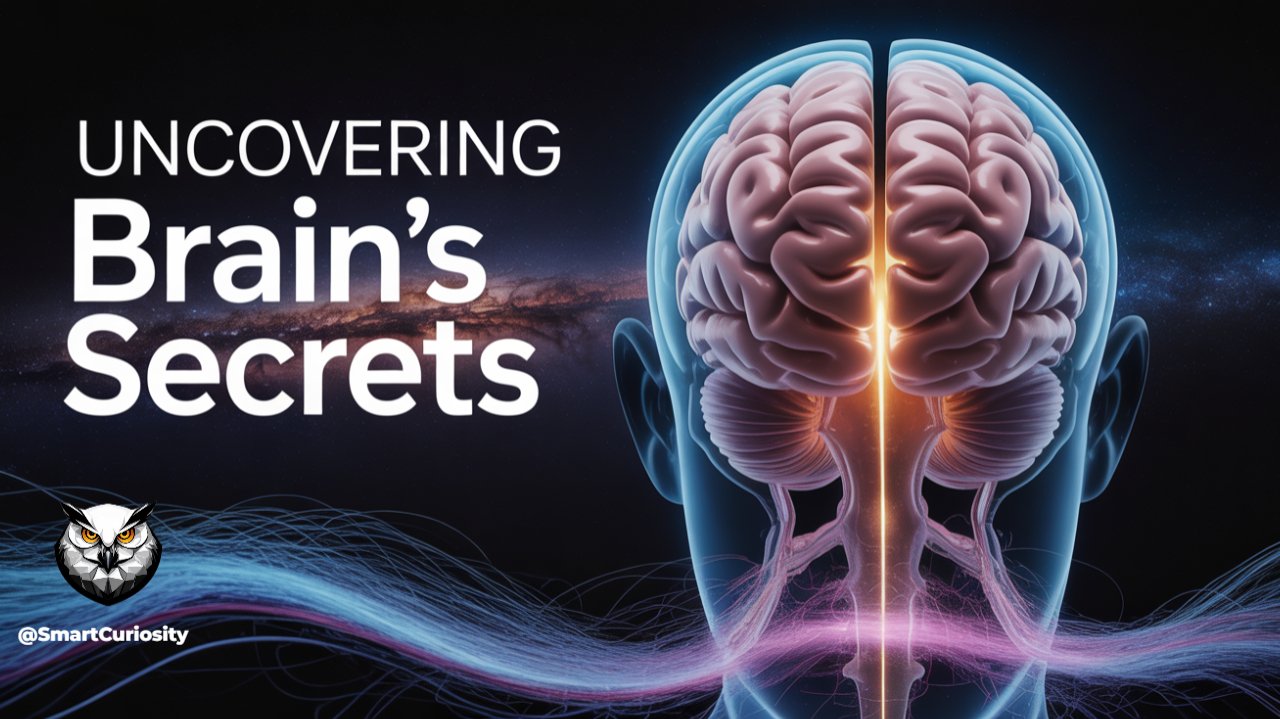We’re about to take a journey into the most complex structure in the known universe. It’s a three-pound clump of fat and protein that somehow manages to slurp up 20% of all your body’s energy, and for good reason. It holds the key to who you are, what you feel, and how you see the world. This is the story of the human brain the organ that literally creates your reality. By the end of this, you won’t just understand its hidden architecture, but also how it gives rise to the biggest mystery of them all: consciousness itself.
Imagine holding the entire known universe in the palm of your hands. It would weigh about three pounds, feel like firm jelly, and be wrinkled like a walnut. This isn’t science fiction; it’s the physical reality of your own brain. Inside, you’ve got roughly 86 billion neurons, each one a tiny biological computer, and they form more connections than there are stars in our galaxy. And get this all of that incredible power runs on just 20 watts of energy, enough to power a dim lightbulb. Yet, from this low-power, biological machine comes every symphony ever composed, every scientific breakthrough, every act of love, and every secret fear. So, how does it do it? How does this one organ build our entire experience of life? To answer that, we have to go inside.
The Grand Architecture – A Guided Tour
To really get the brain, you need a map. We’ll start with the big, obvious structures and work our way down into its hidden chambers. On the highest level, the brain is split into three main parts: the cerebrum, the cerebellum, and the brainstem.
First up, the main event: the cerebrum. This is the part you picture when you think “brain.” It’s that huge, wrinkly mass that takes up most of the room in your skull. The cerebrum is where your conscious thoughts, your personality, your memories, and all your voluntary actions live. It’s split right down the middle into two halves: the left and right hemispheres. Now, you’ve probably heard myths about being “left-brained” or “right-brained,” but the truth is, the two sides are constantly chatting, working together to blend logic with creativity and language with spatial awareness.
So how do they talk? They use a superhighway of nerve fibers called the corpus callosum. This thing is a massive bridge made of about 200 to 300 million nerve fibers, letting the two halves share information and coordinate. It’s thanks to the corpus callosum that you can see an object, have both sides of your brain process it, and reach for it with the correct hand all in one smooth, seamless action. It makes sure your world feels whole, not split in two.
But the coolest feature of the cerebrum is its wrinkly outer layer, the cerebral cortex. Why all the folds? It’s a brilliant evolutionary hack to solve a packing problem. For maximum brainpower, you need a huge surface area. By folding in on itself, the brain can cram a massive sheet of cortex about the size of a large pizza if you laid it flat into your skull. This is the gray matter, the headquarters for all our higher thinking.
Tucked away at the back, underneath the cerebrum, is the cerebellum, which literally means “little brain.” Don’t let the name fool you. It’s way smaller than the cerebrum but packed with neurons and has a huge job. The cerebellum is the master of coordination. Every graceful move, from a ballet dancer’s leap to a surgeon’s steady hand, is fine-tuned by this structure. It manages balance, posture, and motor learning. When you finally learn to ride a bike or play the piano without thinking about it, that’s the cerebellum taking over, automating the complex muscle movements so you can do them smoothly.
Finally, connecting the brain to the body through the spinal cord, we have the brainstem. This is the most ancient, fundamental part of the brain the unsung hero that handles all the vital stuff you never think about. Your heartbeat, your breathing, your sleep-wake cycles, swallowing the brainstem regulates it all. It’s the brain’s 24/7 life-support system, quietly working in the background to keep you alive. It’s made of three parts: the midbrain, the pons, and the medulla oblongata, each handling different automatic functions.
So there are our three main players: the cerebrum for thinking, the cerebellum for moving, and the brainstem for living. But that’s just the bird’s-eye view. The real secrets are buried deeper inside.
The Four Lobes – A Tour of the Cerebrum
The cerebral cortex, that wrinkly outer layer, is where our most advanced skills come from. It’s where raw sensation becomes perception, where thoughts are born, and where our personalities take shape. To make sense of it all, neuroscientists have divided each hemisphere into four sections, or lobes. Just remember, these lobes don’t work alone; they’re all part of a hyper-connected network, constantly talking to each other to build your reality.
Our tour starts right behind your forehead with the frontal lobe. This is the biggest of the four, and in many ways, it’s the part that makes you, you. The frontal lobe is your brain’s CEO. It handles all the “executive functions”: planning, decision-making, problem-solving, and impulse control. When you weigh the pros and cons of a big decision or resist that second slice of cake, that’s your frontal lobe hard at work. It contains the prefrontal cortex, the most recently evolved part of our brain, which steers our personality, social behavior, and our ability to see the consequences of our actions.
But the frontal lobe isn’t just for thinking; it’s for doing. Tucked in the back of the frontal lobe is the motor cortex, a strip of tissue that controls voluntary movement. When you decide to get up and walk, it’s the motor cortex sending the “go” signal down your spinal cord to your leg muscles.
And nestled in the frontal lobe, usually on the left side, is a critical spot for language: Broca’s area. Named after French physician Paul Broca, this area handles speech production. It’s what organizes the muscle movements in your mouth and throat to form words. Damage here can cause expressive aphasia, where someone understands language just fine but can’t speak fluently. They know exactly what they want to say, but the words just won’t come out.
Moving back, we find the parietal lobe, at the top-middle of the brain. If the frontal lobe is the CEO, the parietal lobe is the head of sensory data. Its main job is to process sensations from your body, like touch, temperature, pressure, and pain. It contains the somatosensory cortex, which acts like a sensory map of your body. When you touch a hot stove, it’s the parietal lobe that screams, “That’s hot!”
But it does more than just feel. The parietal lobe is also key for spatial awareness. It helps you understand where you are in relation to everything else, letting you navigate a crowded room or grab a glass of water without knocking it over. It pieces together all your sensory inputs to build a coherent 3D model of the world.
Next, on the sides of the brain behind your temples, is the temporal lobe. Being right next to the ears is a big clue to one of its main jobs: sound. The temporal lobe contains the primary auditory cortex, which receives and interprets everything you hear. It deciphers pitch and volume, letting you tell a violin from a trumpet or recognize a friend’s voice.
But it’s also a powerhouse for language and memory. On the left side is Wernicke’s area, the counterpart to Broca’s area. Wernicke’s area is all about language comprehension understanding what you hear and read. Damage here leads to receptive aphasia, where someone can speak fluently, but their words are a jumbled “word salad,” and they can’t make sense of what others are saying. Deep inside the temporal lobe, we also find the hippocampus, a key player in making new long-term memories.
Finally, our tour ends at the very back of the brain with the occipital lobe. This lobe has one main, incredibly important job: vision. It holds the primary visual cortex, which takes the raw signals from your eyes and starts turning them into images decoding lines, shapes, and colors. From there, it passes the info to other brain areas for higher-level processing, like recognizing a face or reading a word.
So that’s our tour of the cortex. But to understand what really drives us our emotions, our memories, our gut instincts we have to go deeper.
The Inner Chambers – The Limbic System
Buried deep inside the brain is a collection of structures called the limbic system. This is the brain’s emotional core. If the cortex is our rational mind, the limbic system is the source of our primal drives, deep-seated emotions, and our most important memories. It handles the stuff that’s essential for survival: feeding, fighting, fleeing, and… well, you get the idea.
First, we meet the amygdala, two almond-shaped clusters that act as the brain’s alarm system. The amygdala is constantly scanning for threats. That jolt of fear you feel when you hear a sudden loud noise? That’s your amygdala. It’s central to fear, anxiety, and aggression, but it also tags memories with emotional significance. An emotionally charged memory good or bad gets burned into your brain much more strongly. That’s why you remember your first kiss but not what you had for breakfast last Tuesday.
Right next door is the hippocampus, a seahorse-shaped structure that’s the brain’s memory-formation hub. It’s not where memories are stored for good, but it’s where they’re first created and consolidated. The hippocampus turns short-term experiences into lasting memories that get filed away elsewhere in the cortex. It’s absolutely vital for forming the memories that make up the story of your life.
Next up is the tiny but mighty hypothalamus. This little structure is the brain’s master regulator, linking the nervous system to the hormone system. Are you hungry? Thirsty? Too hot or too cold? That’s your hypothalamus talking. It keeps your body’s internal environment in a stable, balanced state called homeostasis.
Finally, there’s the thalamus, the brain’s central relay station. Nearly every piece of sensory information everything you see, hear, taste, and touch passes through the thalamus before getting routed to the correct part of the cortex for processing. The only sense that gets a direct pass is smell. The thalamus acts like a filter, deciding what sensory information is important enough to reach your conscious awareness.
Together, these deep structures are the powerful engine of our inner world, generating the emotions that color our lives and the memories that define us.
The Engine Room – Brainstem and Cerebellum Revisited
We’ve seen the executive offices of the cerebrum and the emotional heart of the limbic system. Now, let’s head down to the engine room the parts that work 24/7 without you ever having to think about them.
Let’s look again at the cerebellum, the “little brain.” It contains more than half of all the neurons in your entire brain, all dedicated to making your movements smooth, accurate, and automatic. Think about learning to type. At first, your fingers are clumsy, and you have to concentrate on every key. But with practice, it becomes fluid and effortless. That’s your cerebellum taking over. It learns the motor program so your conscious mind is free to think about what you want to write, not how to type it. The cerebellum is constantly comparing your intended movements with your actual movements and making real-time corrections. Without it, our actions would be jerky and uncoordinated.
Now for the brainstem, the stalk that connects everything to the spinal cord. If the cerebellum is the master of movement, the brainstem is the master of life itself. At the very bottom is the medulla oblongata, which controls your most critical automatic functions: your heart rate and your breathing. It also handles reflexes like swallowing and sneezing.
Just above it is the pons, which means “bridge.” It serves as a major connection point, relaying signals between the cerebrum and cerebellum. It’s also involved in controlling breathing and plays a key role in dreaming.
At the top is the midbrain, a relay station for visual and auditory information that helps control eye movements. And running through the brainstem’s core is the reticular activating system (RAS). This is the brain’s gatekeeper for consciousness. It controls your level of alertness. When your alarm goes off in the morning, it’s the RAS that flips the switch and brings your brain online.
Section 5: The Neural Symphony – How It All Communicates
We’ve toured the brain’s architecture, but the real show happens at the microscopic level. It’s an electrochemical symphony played by 86 billion specialized cells called neurons.
A neuron has branches called dendrites that act like antennas, receiving signals, and a long cable called an axon that sends signals out. Inside a single neuron, the signal is electric. When a neuron gets enough input, it fires an electrical spike an action potential that zips down the axon. To make it faster, many axons are wrapped in a fatty substance called myelin, which works like insulation on a wire.
But here’s where the magic happens. Neurons don’t actually touch. There’s a tiny gap between them called a synapse. The electrical signal can’t jump that gap. So, when the action potential reaches the end of an axon, it triggers the release of chemical messengers called neurotransmitters. These chemicals drift across the synapse and latch onto the next neuron, either exciting it to fire or telling it to stay quiet.
This whole process electric, then chemical, then electric again happens trillions of times every second. There are dozens of different neurotransmitters. Some, like dopamine, are tied to reward and movement. Others, like serotonin, help regulate your mood. The precise balance of these chemicals is everything. This intricate dance is the language of the brain. Every thought, memory, and feeling is the result of this neural symphony.
If this journey into the brain has sparked your curiosity and you want to keep exploring the incredible science of who we are, make sure to subscribe for more deep dives into the human mind, body, and the frontiers of science.
Section 6: The Great Frontier – The Mystery of Consciousness
So we’ve seen the brain’s machinery. We know how it works. But that brings us to the biggest, most mind-bending question of all: Why? Why does all this processing actually feel like something? How does a physical brain produce subjective experience? In short, where does consciousness come from?
For centuries, this was a question for philosophers. But today, neuroscientists are tackling it head-on, and a few fascinating theories are leading the charge.
One is the Global Neuronal Workspace Theory (GNWT). This idea suggests consciousness emerges when information gets access to a specific brain network, mainly in the prefrontal and parietal lobes. Think of it like a global stage. Most brain processing happens unconsciously, “backstage.” But when information is important enough, it gets broadcast onto this main stage, making it available to all the other systems. According to GNWT, this global broadcast is what we experience as conscious awareness.
A rival idea is the Integrated Information Theory (IIT). IIT proposes that consciousness is a fundamental property of any system that has a certain kind of complexity one that is both highly interconnected and highly differentiated. In other words, its whole is greater than the sum of its parts. IIT argues consciousness arises from a “hot zone” in the back of the cortex and can even be measured mathematically.
In an unprecedented scientific showdown, proponents of both theories recently put them to the test in a series of experiments, with the complex results published in 2025. It turned out that neither theory was a clear winner, and both ran into some trouble. For instance, some of GNWT’s predictions about activity in the frontal cortex didn’t fully pan out, while IIT’s predictions about synchronized activity in the posterior “hot zone” weren’t observed as expected.
What this landmark study really showed is that the truth is likely far more complicated than any single theory. The quest to understand consciousness is pushing the very limits of science. And this brings us to one of the most hopeful concepts of all: neuroplasticity. The brain isn’t a static machine; it’s constantly changing and rewiring itself based on your experiences. Every time you learn something new, you physically alter the structure of your brain. This is how we learn, adapt, and literally become who we are.
We started our journey holding the universe in our hands a three-pound organ of mind-boggling complexity. We’ve toured its grand structures, from the thinking cerebrum to the life-sustaining brainstem. We’ve met the lobes that build our reality and explored the deep, emotional core where fear and memory are born. We’ve witnessed the lightning-fast symphony of neurons that is the very language of the mind.
And we’ve ended here, at the edge of human knowledge, staring into the profound mystery of consciousness itself. The brain is the ultimate frontier. It’s the tool we use to explore the universe, yet it remains the most puzzling part of it. The secrets we’ve uncovered today are just the beginning. The ongoing quest to understand this incredible organ is, ultimately, the quest to understand ourselves. And that journey has only just begun.





